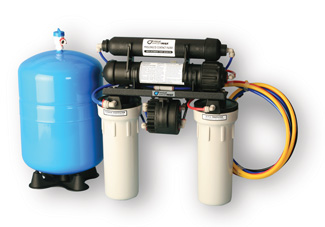Reverse Osmosis Water Filtration
 Your water can be divided into three groups;
Your water can be divided into three groups;
- Working water, water used to wash your car, water the grass etc.
- Utility water, water used for washing clothes, dishes, bathing.
- Life support water, water used for drinking and preparing food.
At Hague we recommend using reverse osmosis water filtration to provide your family with high quality life support water.
Reverse osmosis water filtration typically includes several steps:
- A sediment filter to trap particles including rust and calcium carbonate from the water supply. The Hague H3500 RO system employs a dual function pre filter which also contains activated carbon, to trap organic chemicals and chlorine, which will attack and degrade TFC (Thin Film Composite) reverse osmosis membranes
- The second stage of reverse osmosis water filtration is a semi permeable reverse osmosis (RO) filter which is a thin film composite membrane (TFM , TFC or CTA)
- Reverse osmosis water filtration may be used on well or municipal water. For municipal water which is typically treated with chlorine a cellulose triacetate membrane (CTA) is used. The CTA membrane is prone to rotting unless protected by chlorinated water, while the TFC membrane is prone to breaking down under the influence of chlorine.
- The next stage of the H3500 reverse osmosis water fitration is the prolong contact filter. This is a “polishing” stage where any remaining chlorine or organics are removed from the product water.
- From the prolonged contact stage, the water is stored in the holding tank until needed.
- Once the water is drawn from the holding tank, it passes through a final carbon post filter. This is to ensure any taste that may have been picked up in the holding tank is removed before use.
At Hague we recommend that a reverse osmosis water filtration system be preceeded by a Watermax water softener. Softened water will greatly extend the life of your reverse osmosis water filter.